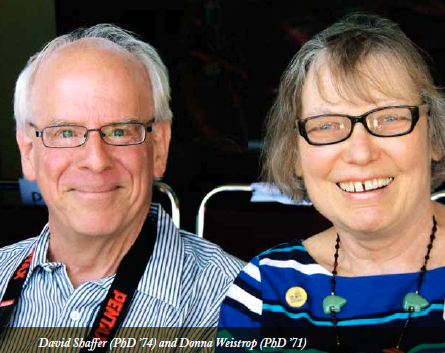Astronomer couple Donna Weistrop and David Shaffer recently realized a way to advance research beyond their own careers—philanthropy. Among other gifts, the couple has made a trust provision that will establish the David Shaffer and Donna Weistrop Discovery Fund in Astronomy at Caltech.
 “Caltech has always been one of the leading research institutes in the world. I wanted to go to Caltech because I thought it was the best.”
“Caltech has always been one of the leading research institutes in the world. I wanted to go to Caltech because I thought it was the best.”
—Donna Weistrop (PhD ’71)
Caltech’s Fifth Female Astronomy PhD
With pioneering spirit, Donna Weistrop forged her own path in astronomy. As a college senior in 1965, she won a prestigious Woodrow Wilson Fellowship that essentially freed her to go wherever she wanted. She went to Caltech, which had few female students and no female astronomy professors at the time. She remembers feeling a weighty responsibility to represent women well in her every action.
At Caltech, Weistrop’s adviser was Maarten Schmidt, now the Francis L. Moseley Professor of Astronomy, Emeritus, who had shocked scientists in 1963 by identifying quasars as the most distant, luminous objects yet observed—signifiers of a huge and violent universe.
Weistrop’s career after Caltech included years at Tel Aviv University and NASA and in private industry. She ultimately landed at the University of Nevada, Las Vegas, where, as a professor of physics, she was a co-investigator on the team that built a new spectrograph for the Hubble Space Telescope.
“People in the science community know that there’s no better place to come from.”
—David Shaffer (PhD ’74)
Astronomer-Geoscientist
Weistrop’s Caltech classmate David Shaffer studied with Marshall Cohen, now a professor emeritus. Then a new professor, Cohen was advancing a technique called very-long-baseline interferometry. By combining observations from radio telescopes around the world to gather more information, this method brought high resolution to radio astronomy.
“He and I sort of broke the rules together,” Shaffer says.
Shaffer also worked for several organizations after leaving Caltech, but he spent most of his career at NASA. There, he advanced radio interferometry—in reverse. He turned his focus from sky to Earth, using celestial reference points and the slowly changing positions of the radio telescopes themselves to contribute to the first precise measurements of tectonic plate motion.
Satisfied Philanthropists
The discovery fund that Shaffer and Weistrop are endowing at Caltech will support special initiatives, particularly in radio and optical astronomy.
We have seen where a few bucks to do something like develop new equipment is very useful,” Shaffer says. He recalls Cohen tapping discretionary funds from Caltech’s president to buy an amplifier that made a big difference in their experiments.
“I’m hoping the discovery fund will provide opportunities for people to do things they otherwise might not be able to—go to meetings or take on new projects,” Weistrop adds. “I also hope it indicates to women in astronomy that there is a good future for them. When I was at Caltech, it was very difficult being a woman and there was little encouragement. I hope that just having my name on this gift will show female students that they can have successful careers and give back.”
Shaffer and Weistrop feel thankful that Caltech introduced them to the international scientific community—men and women they see as united by respect for facts and the desire to learn how things work and solve problems.
Now, the couple hopes their giving will pique interest among other members of that community.
“We’ve sort of learned philanthropy in the past 15 years,” Shaffer says. “I’m pretty sure that some people with comparable backgrounds may not realize the good things they can do. We hope they might be inspired.”


